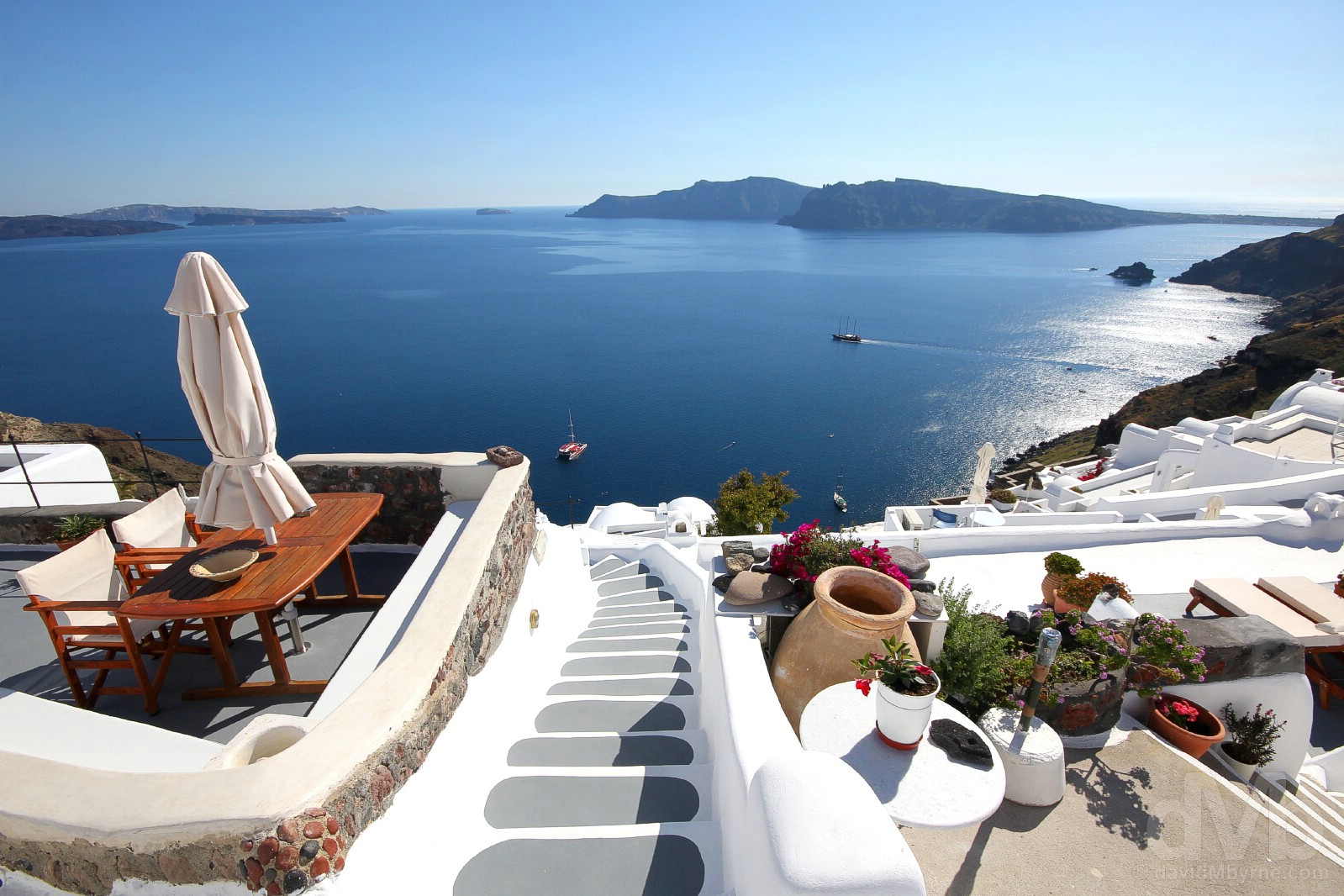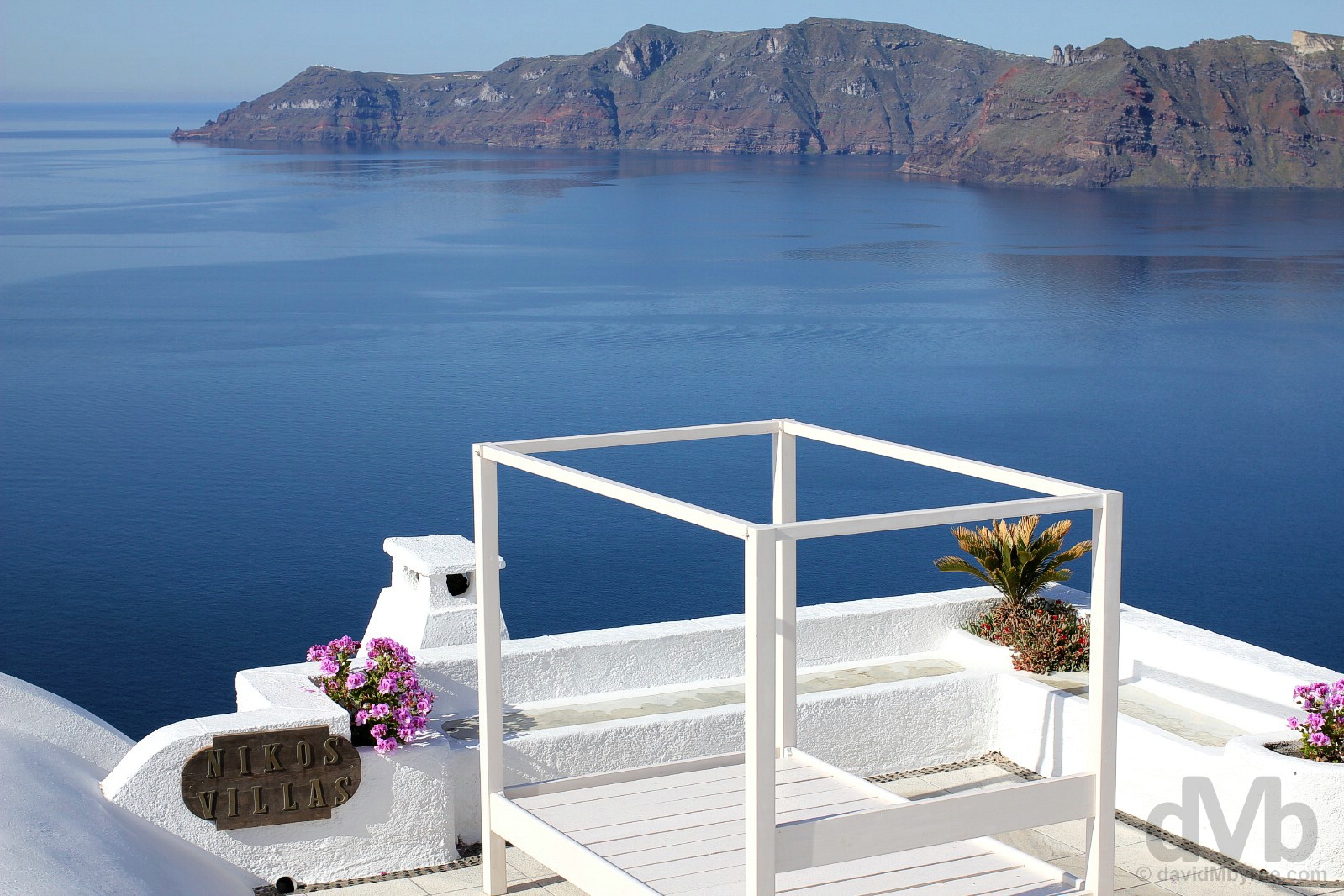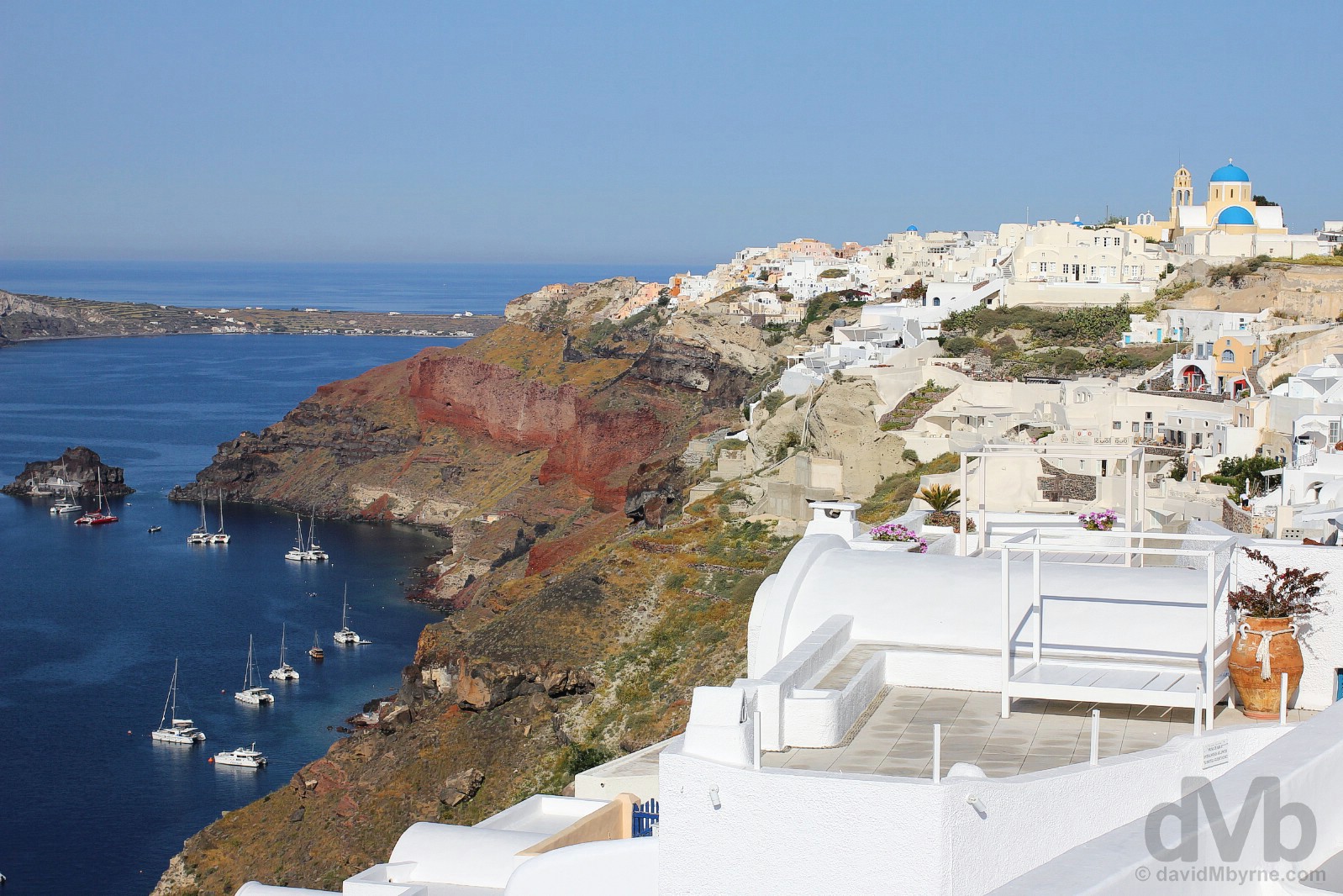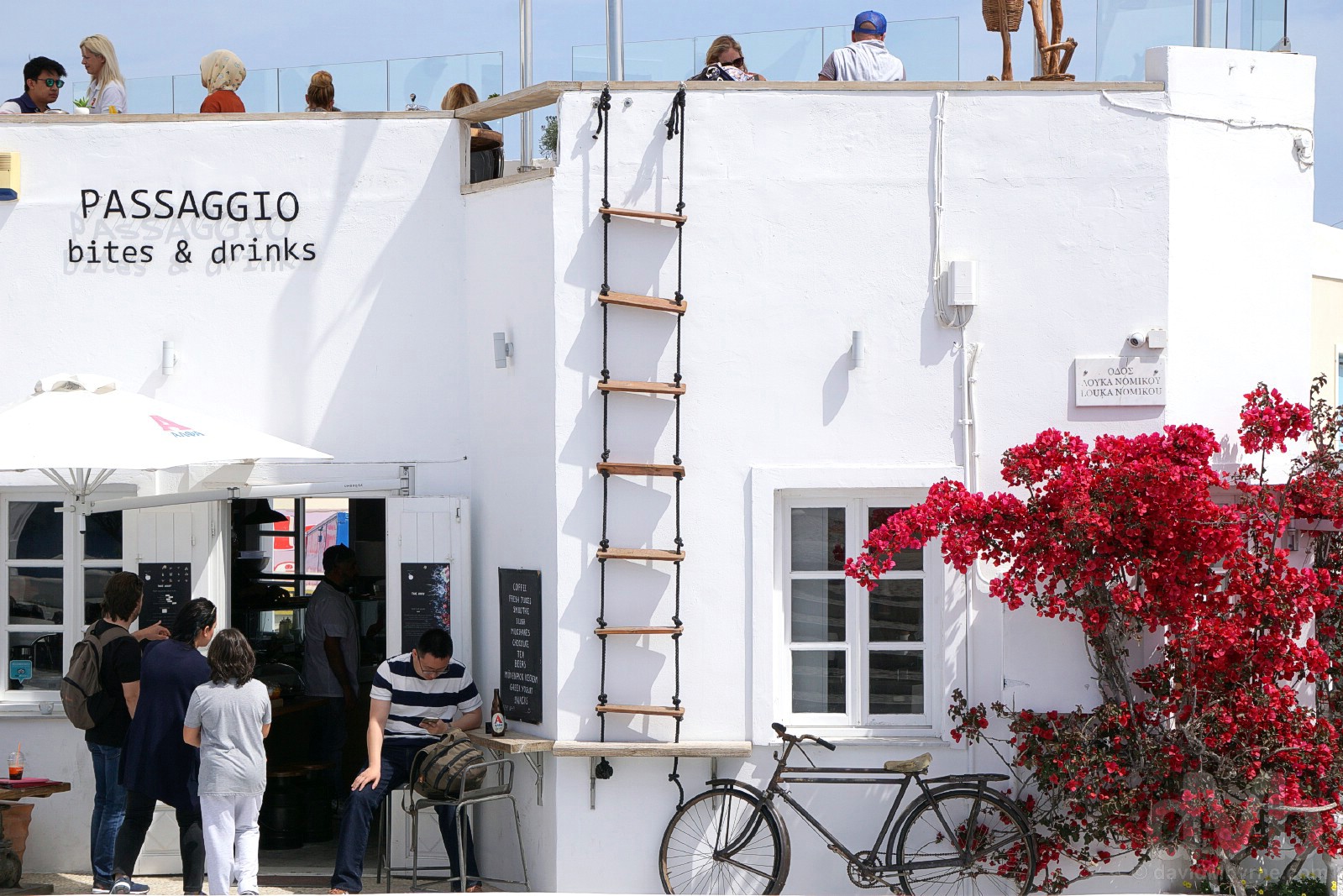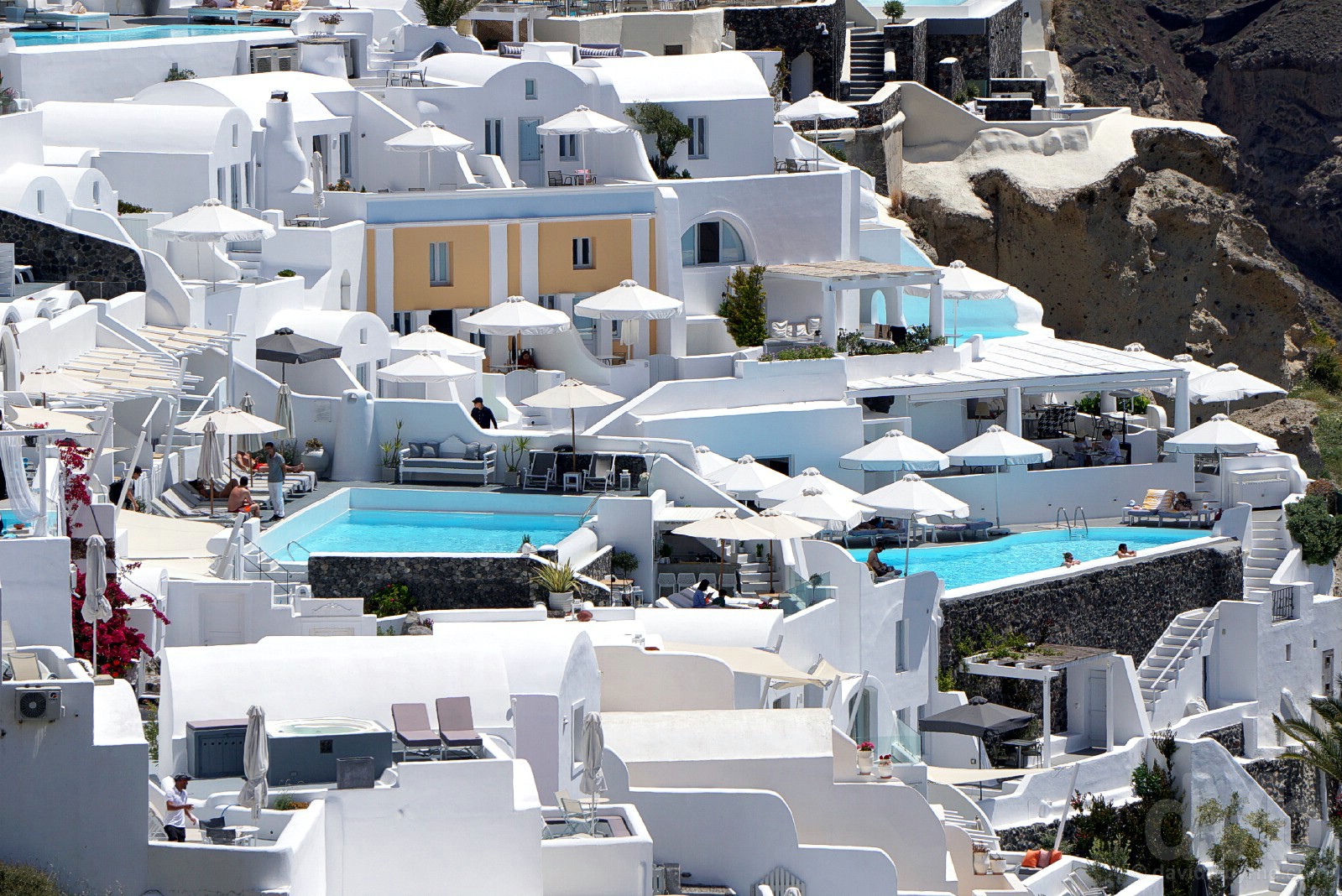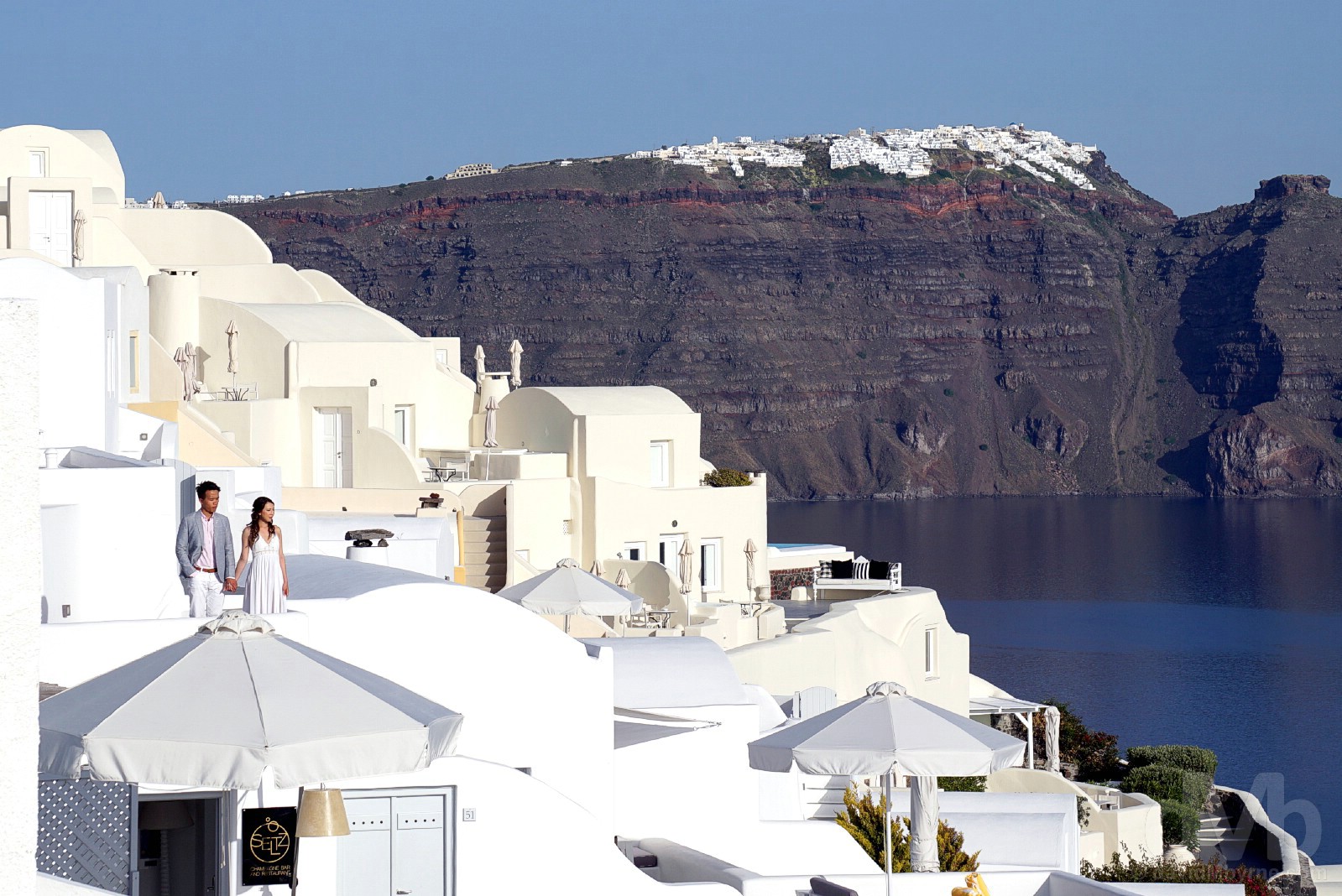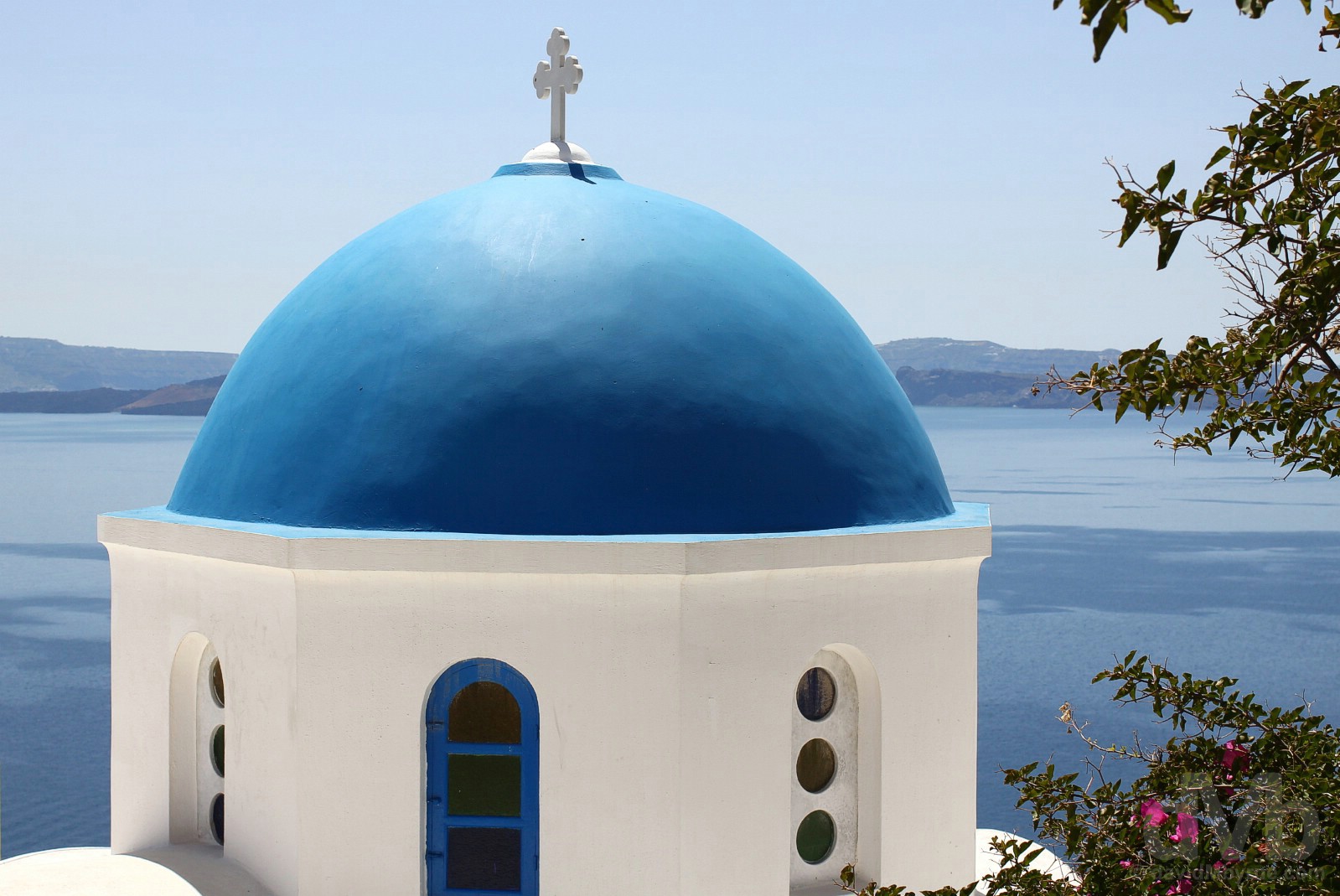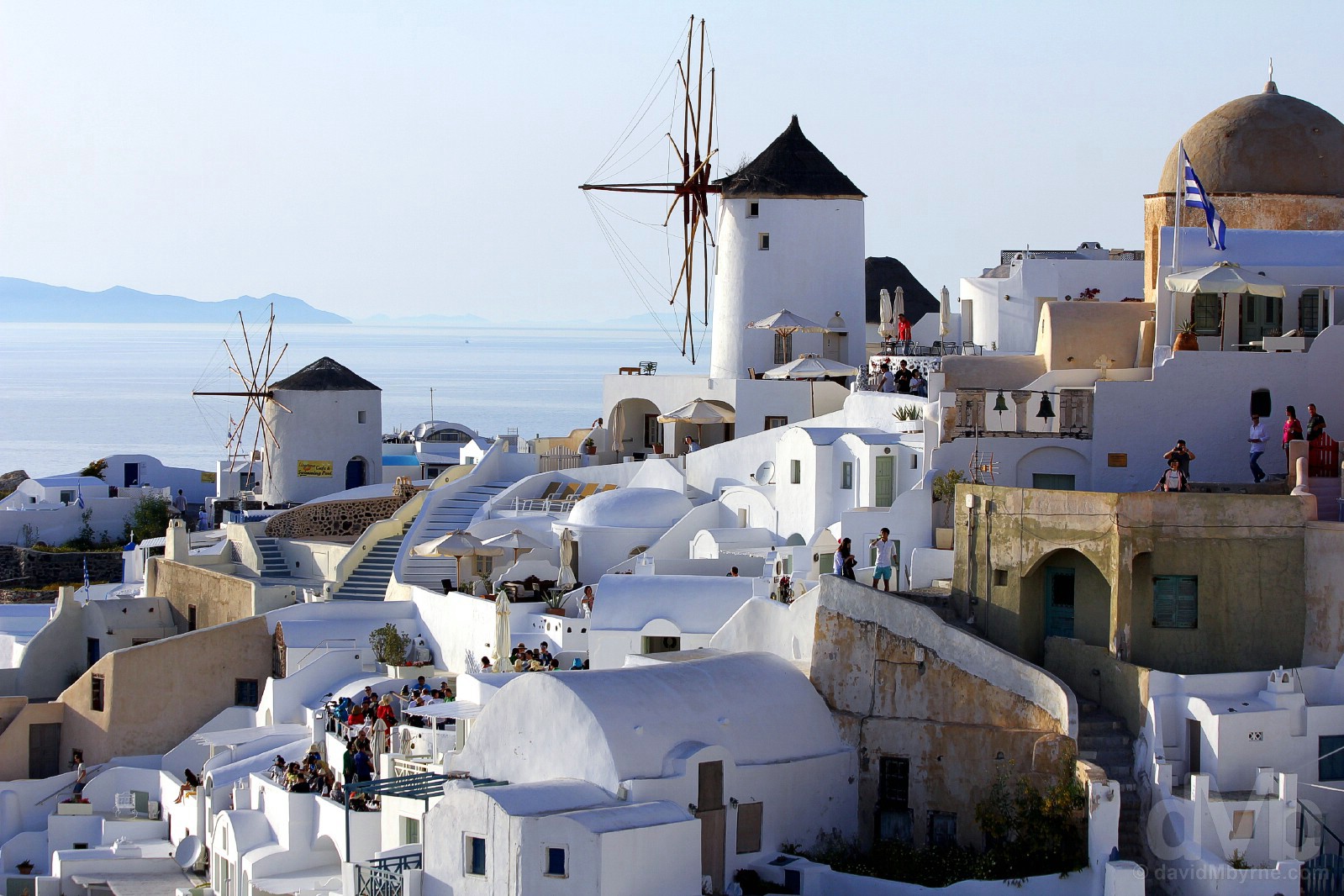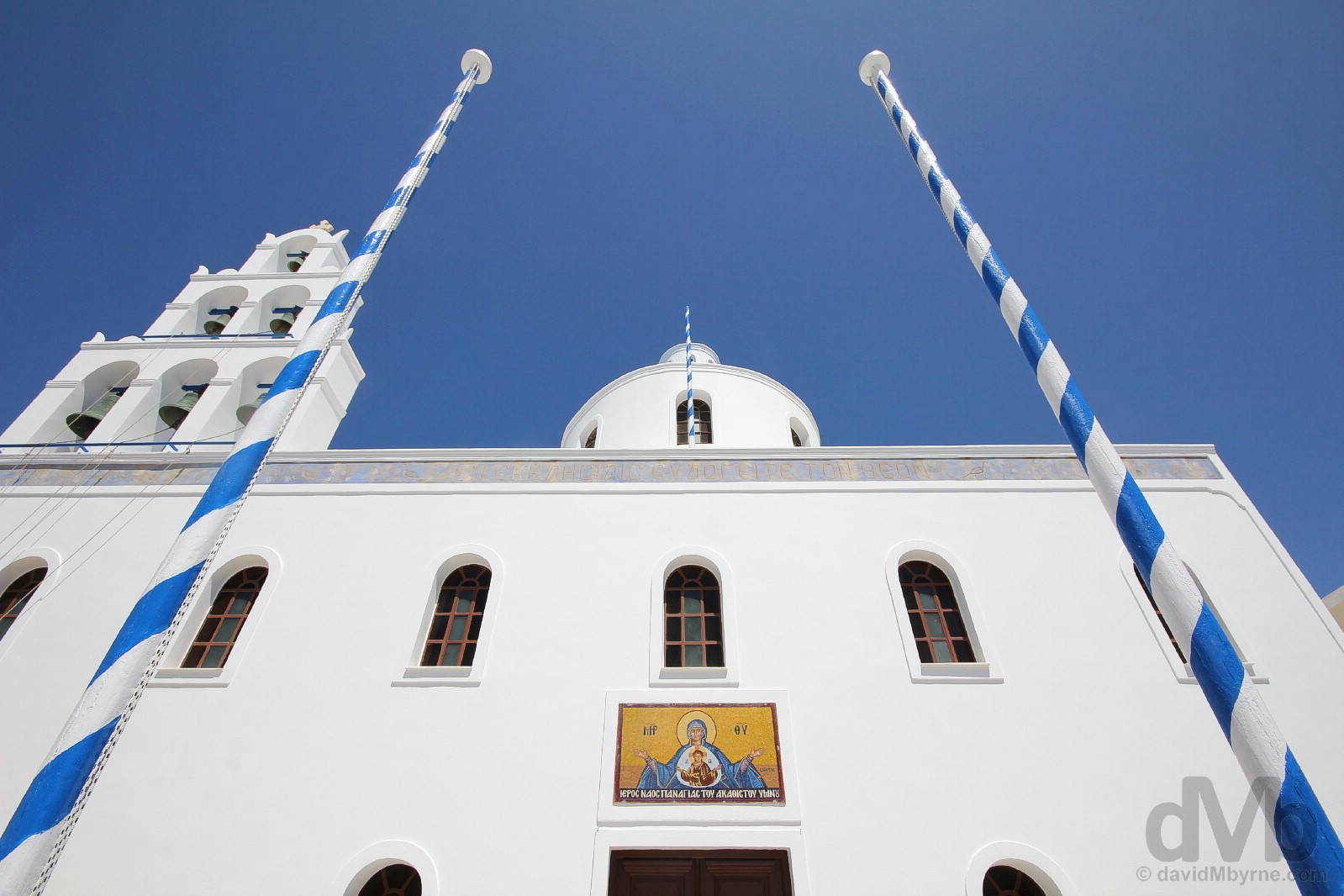Santoríni, Greece
”… a somewhat exclusive destination of unparalleled global appeal, a place-to-see-before-you-die location par excellence. Oozing romance and voguish in the extreme, its world-famous vistas, landscape, architecture, and cave house infinity pools have graced the pages of nearly every glossy travel or lifestyle magazine ever printed and formed the backdrop for many a bikini-clad fashion model shoot, (staged) social media influencer selfie, or dreamy wanderlust-inspiring GoPro video footage.”
Image || Iconic Santoríni. Dusk over the village of Oia. April 28, 2017.
Santoríni, Cyclades, Greece
As the poster child for all sun-drenched Greek islands, Santoríni is scarcely a secret. Hasn’t been for a long, long time. A tourism hotbed stretching back to the early 1970s, the tourist hordes have long since changed the traditional way of life of this particular Cyclades island escape.
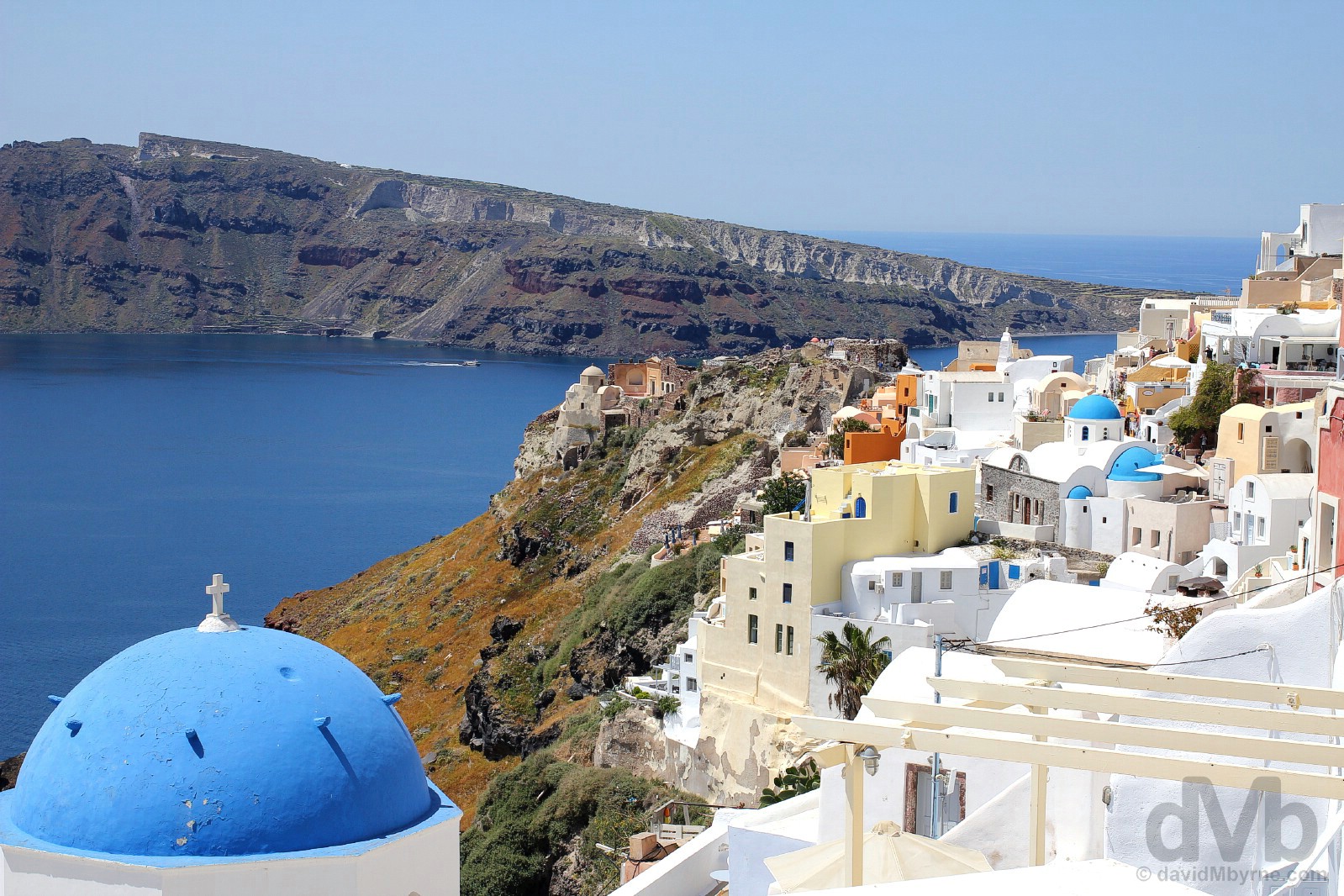
The Cyclades standard cubist architecture and blue domes in the picturesque clifftop village of Oia, Santoríni, Cyclades, Greece. April 28, 2017.
dMb Country Overview - Greece
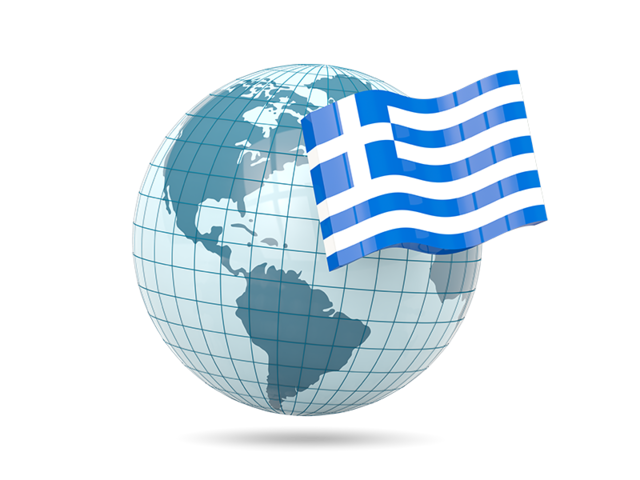 Greece
Greece
Region – Southeastern Europe/The Balkans (dMb tag: The Balkans). Capital – Athens. Population – 10.8 million. Official Language – Greek. Currency – Euro (€) GDP (nominal) per capita – US$21,000 Political System – Unitary parliamentary republic. EU Member? – Yes (10th member joined January 1981). UN Member? – Yes (founding member joined October 1945). G20 Member? – No. Size – 132,000 km² (Europe’s 15th largest country is approximately half the size of Ecuador, twice the size of Sri Lanka, and roughly the same size as the US southern states of Alabama and Louisiana. Topography – A mountainous interior (80% of Greece is mountainous), a long and convoluted coastline, and hundreds of offshore islands. Independence – 1830 from the Ottoman Empire following 1821 to 1830 Greek War of Independence. Brief History – From the eighth century BC, the Greeks were organised into various independent city-states, known as poleis (singular polis), which spanned the entire Mediterranean region and the Black Sea. Philip of Macedon united most of the Greek mainland in the fourth century BC, with his son Alexander the Great rapidly conquering much of the ancient world, from the eastern Mediterranean to India. Greece was annexed by Rome in the second century BC, becoming an integral part of the Roman Empire and its successor, the Byzantine Empire, which adopted the Greek language and culture. The Greek Orthodox Church, which emerged in the first century AD, helped shape modern Greek identity and transmitted Greek traditions to the wider Orthodox World. After falling under Ottoman dominion in the mid-15th century, Greece emerged as a modern nation state in 1830 following a war of independence. UNESCO World Heritage sites – 18. Tourism Catchphrase/Slogan – All Time Classic. Famous For – Endless coastline and beaches; shipping; democracy (born here); a classical and hallowed past; ouzo; sun-drenched islands; Alexander the Great; the Olympics; being the cradle of Western civilisation; food (tzatziki, feta, souvlaki, moussakas, yogurt, grapes, olives and olive oil); economic collapse & austerity.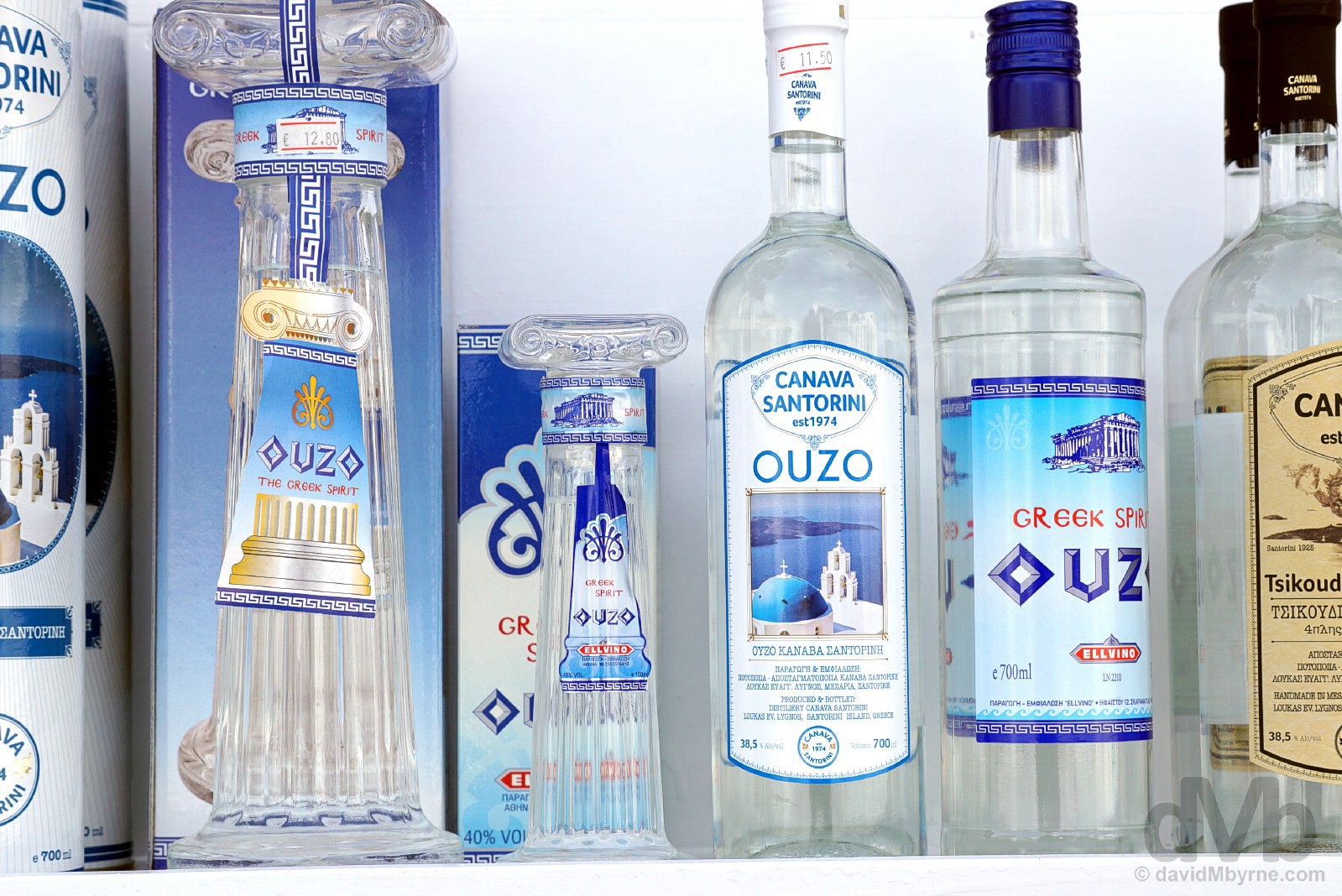
Ouzo for sale in the village of Oia, Santoríni, Cyclades, Greece.

Ouzo for sale in the village of Oia, Santoríni, Cyclades, Greece.
Highlights – Cyclades island-hopping and the remnants of all that ancient history (Greece boasts four millennia of sun-bleached ruins, artefacts, and architecture). Greece Titbits – At nearly 14,000 km (8,500 miles), Greece has the 11th longest coastline in the world; Greece is considered the cradle of Western civilisation, being the birthplace of democracy, Western philosophy, Western literature, historiography, political science, major scientific and mathematical principles, Western drama, and the Olympic Games (the country’s rich historical legacy is reflected in part by its 18 UNESCO World Heritage Sites, as of 2017); the Greek economy is the largest in the region with an economy larger than all other Balkan countries combined, this despite its well-documented economic battering and subsequent austerity measures.
Visits – 2 (May 2008 and April/May 2017). Where I Went/What I Saw – Thessaloniki; The Cyclades (Santoríni, Paros, Mykonos, Delos, Tinos); Zakynthos/Zante; Olympia; Sparta; Mystras; Athens.
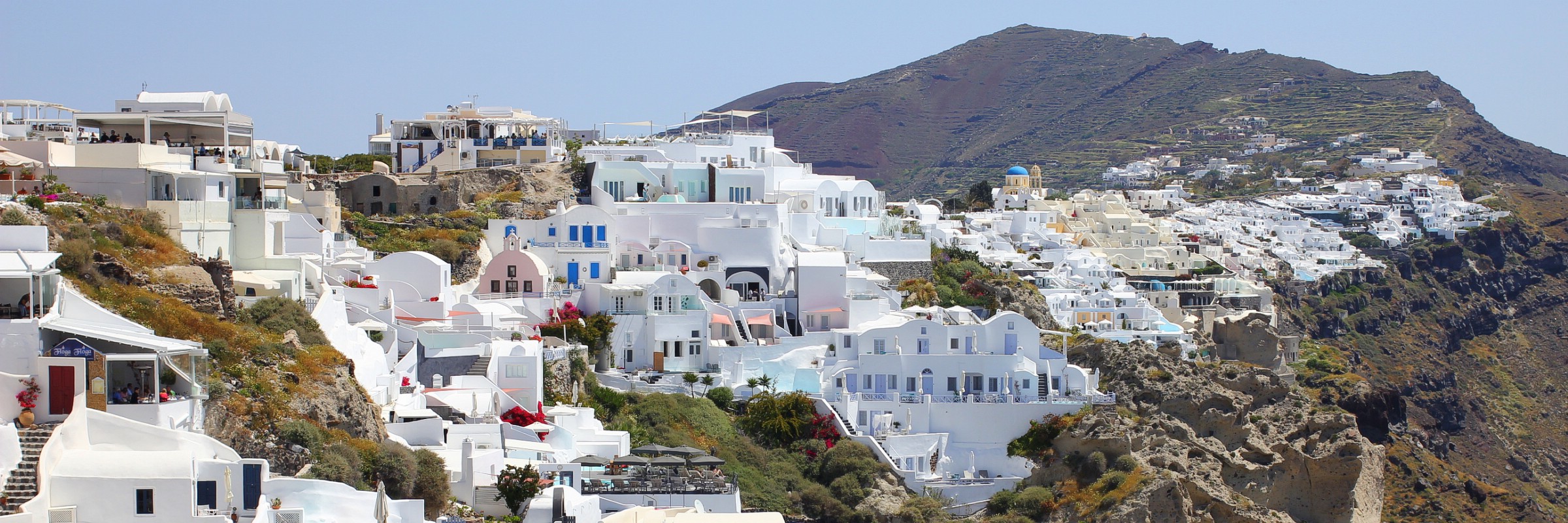
A portion of the clifftop village of Oia, Santoríni, Cyclades, Greece. April 28, 2017.
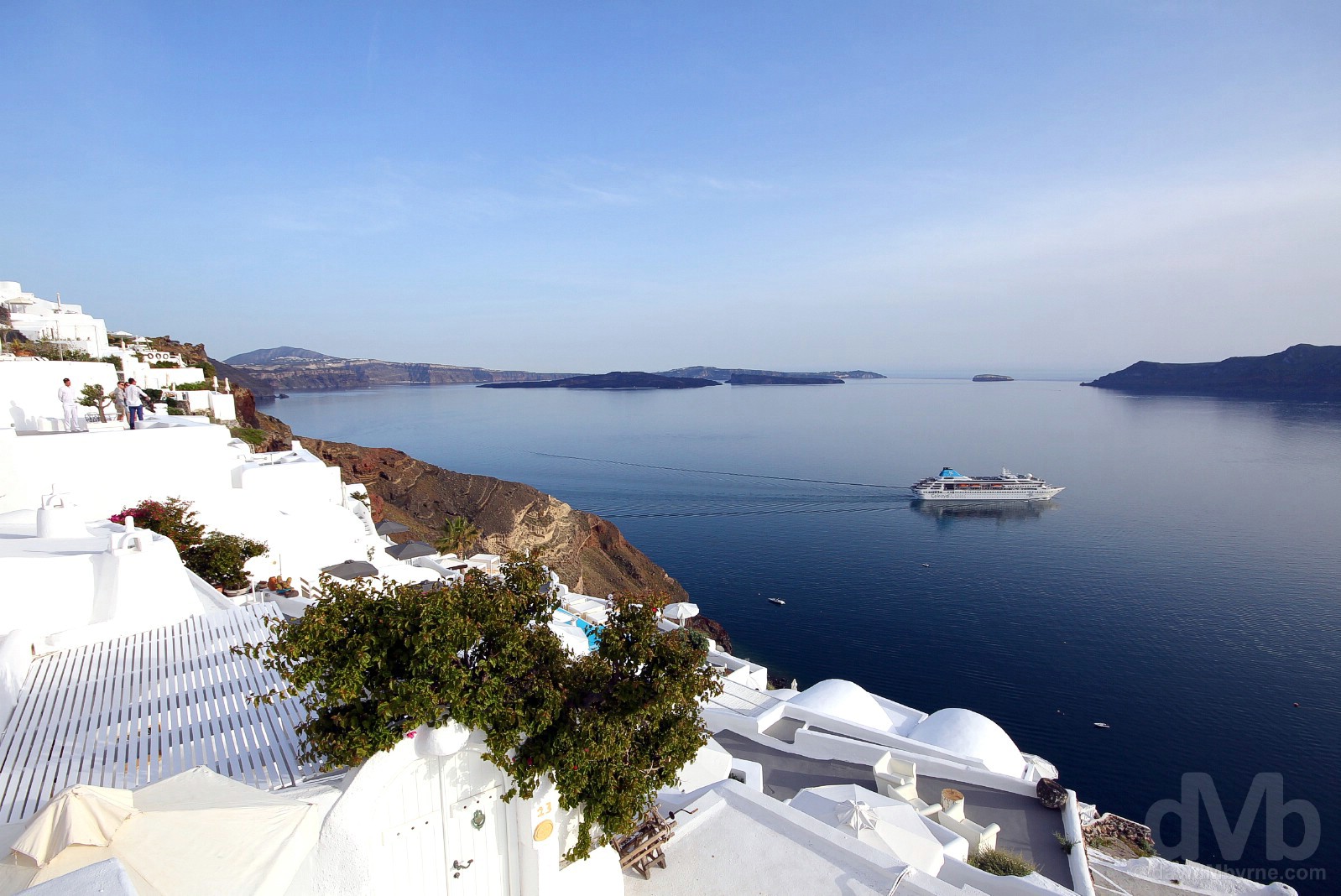
A departing ferry disturbing the evening caldera perfection in Santoríni, Cyclades, Greece. April 29, 2017.
You could easily fly here from the mainland, some 200 Kilometres (120 miles) or so to the northwest. But where’s the fun in that, and why the rush? Island-hopping via ferry is an unrushed and integral part of the Greek escape, one not to be missed. Offering Greece’s best island-hopping, the Cyclades island group, named for the circle they form around the sacred island of Delos, comprise of over 200 islands in total scattered across the azure Aegean Sea between the Greek mainland and Crete. The majority of the Cyclades are small uninhabited ocean-piercing mountain tops. Only two of them, Santoríni being one (Milos the other), are volcanic in nature. Of the 20-plus main islands, some are household names with Santoríni, the most southern of all the Cyclades, probably the most famous of the lot. And only once in your lifetime will you sail into its caldera for the first time, something you can’t do on an aeroplane. Doubtless it’s a moment I’ll never forget.
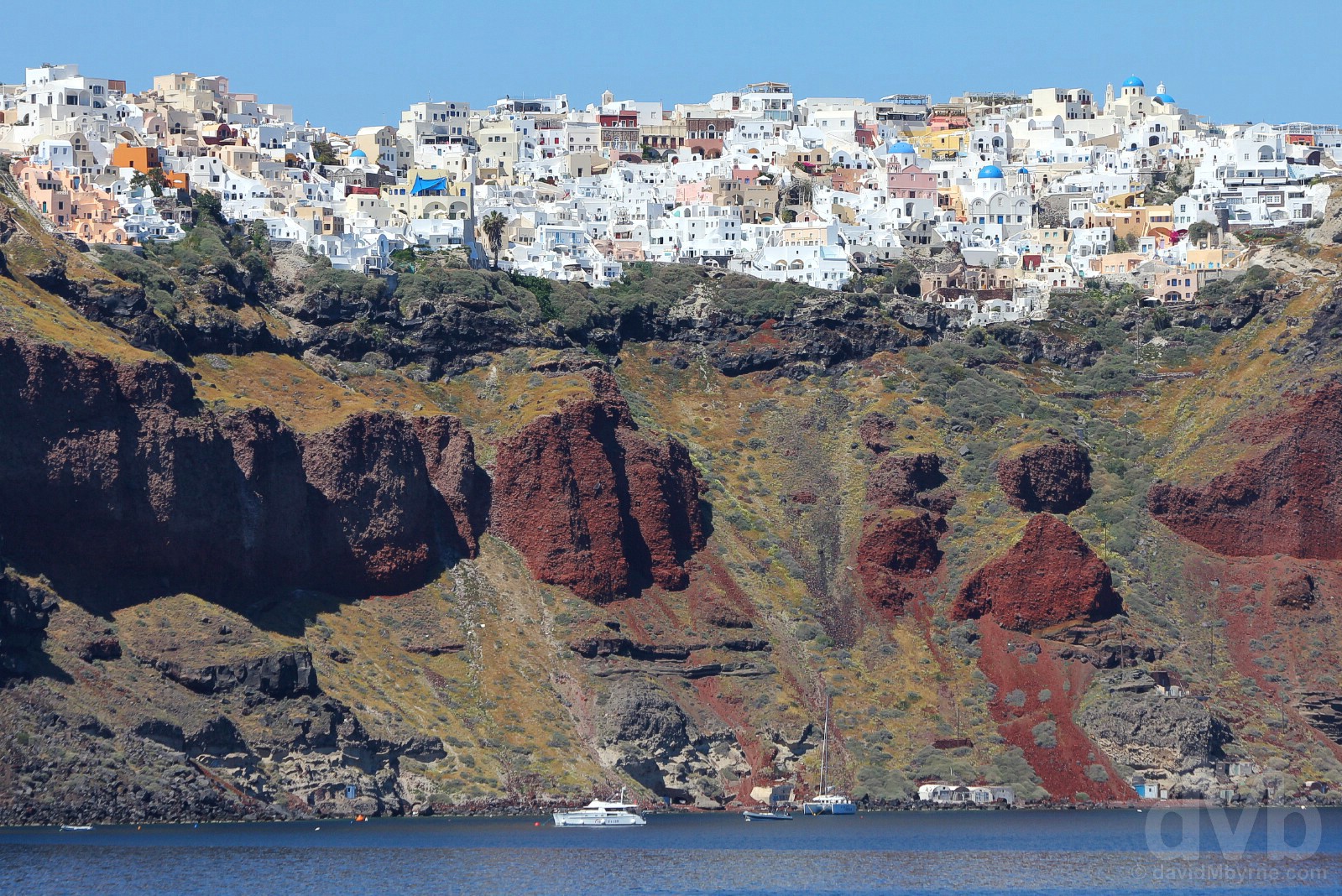
CALDERA | The clifftop village of Oia as seen from the waters of the caldera. Santoríni, Cyclades, Greece. April 27, 2017.
It’s one of those indelible travel memories, the first glimpse, which quickly turns into an intense gaze, of one of the world’s most dramatic sights, the sheer 300-metre-high curtain wall of reddish-brown, black and grey pumice layered cliffs of the Santoríni caldera as the ferry glides past approaching the end of the 5-hour sail from Pireas port outside Athens on the mainland (you can savour it upon departure too, although the reverence is diminished by then). As impressive as Santoríni is from up there (and it is), the full dramatic impact of the unique landscape of this island can only really be appreciated from down here.

Santoríni even shines at night. The village of Oia, Santoríni, Cyclades, Greece. April 28, 2017.
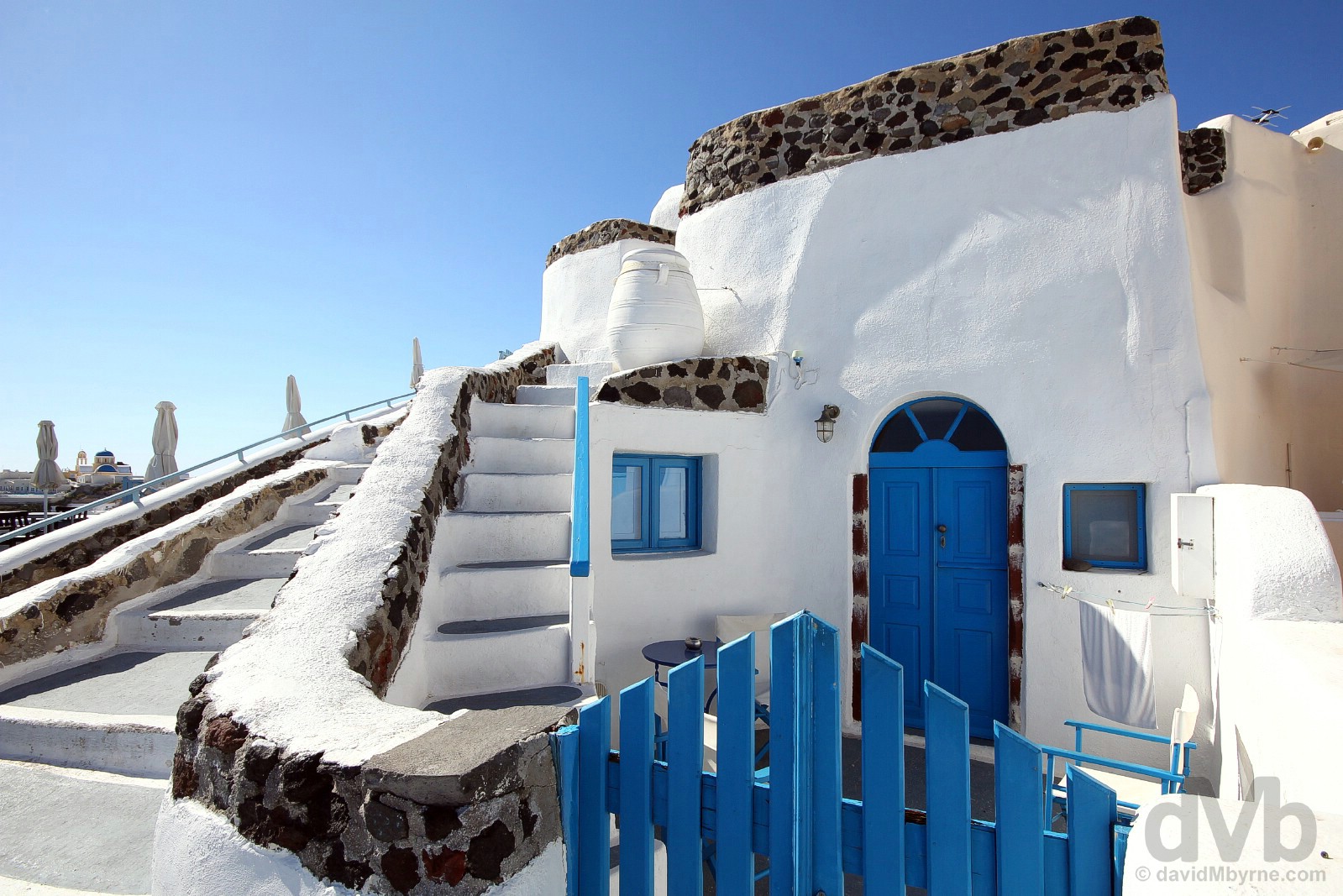
CAVE HOUSE | A traditional whitewashed Cave House overlooking the caldera in the village of Oia, Santoríni, Cyclades, Greece. April 27, 2017.
While Santoríni shares the iconic spectacle of its (mostly whitewashed) cubist architecture and blue-dome churches with the rest of the Cyclades, the island boasts its own unique architectural feature when it comes to cave houses. Stretching back centuries, they were hewn into the steep cliff faces by island inhabitants who couldn’t afford to build on the limited land available elsewhere on the island. The abodes, whose volcanic rock helps to regulate internal temperatures year-round, were functional (just) but rarely spacious and a far cry from the two-story neo-classical mansions built by wealthy island inhabitants. The tourist boom of the 1970s revived not only Santoríni but all of the then economically deprived Cyclades, and today you’ll find the former houses of the poorest island inhabitants enlarged and converted into luxury villas and suites for the well-heeled traveller, the (really) high-end dwellings (upwards of €1000 a night) boasting every conceivable amenity including private infinity pools, hot tubs, plunge pools, and even butler service.
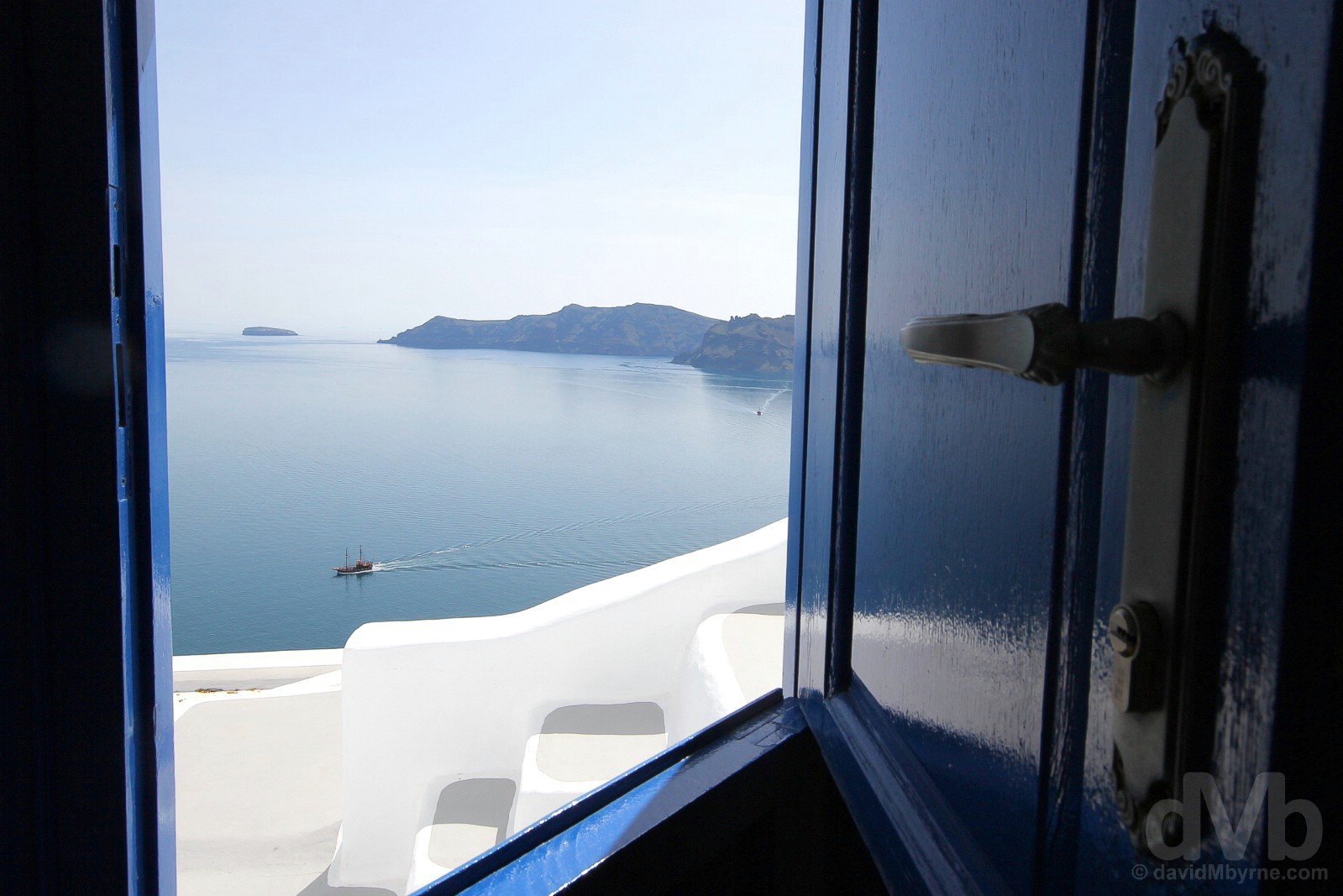
This Cave House did not come with butler service. Nor a private infinity pool. It also did not cost €1000 a night but, crucially, did come with €1000-a-day Santoríni caldera views. It was nice opening this door of a morning. Olympic Villas Cave House 134, Oia, Santoríni, Cyclades, Greece. April 29, 2017.
Santoríni’s idyllic beauty, with its pretty sugar cube dwellings tumbling down the steep cliffs of a part-sunken caldera à la icing on a cake, belies its formation as the result of such an apocalyptic event, one that scarcely concerns the modern-day tourist but one I’m sure they are grateful for (assuming they are even aware of it).
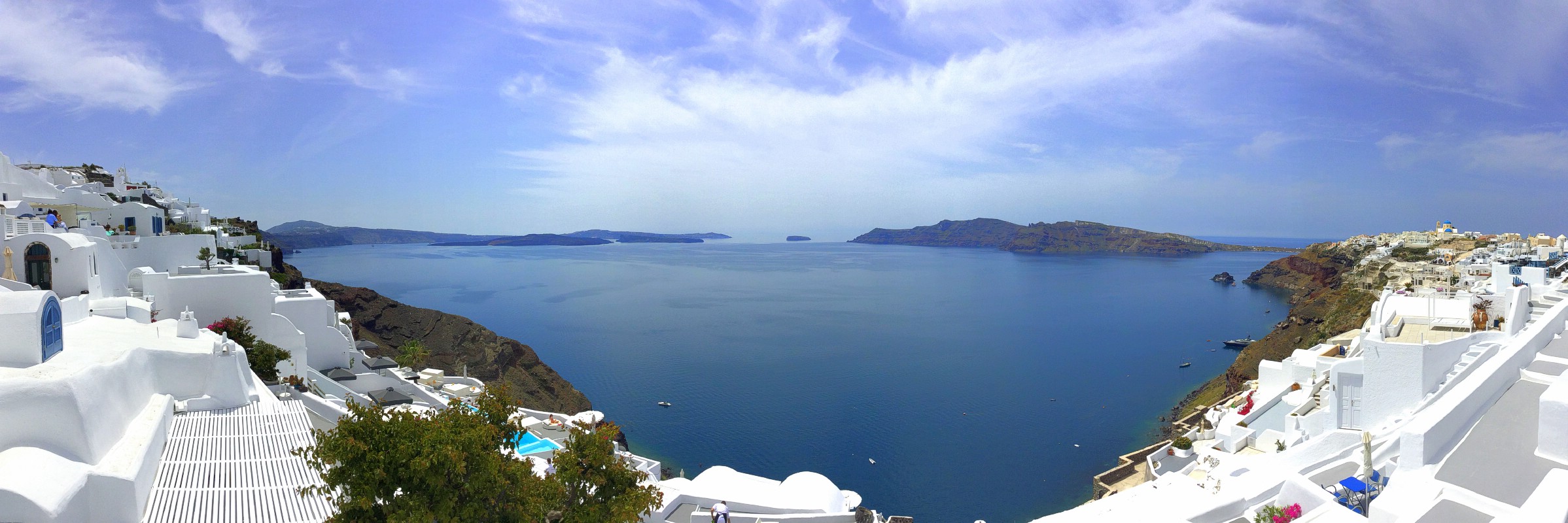
BOOM! | Caldera panorama as seen from the veranda of Olympic Villas Cave House 134 in the village of Oia, Santoríni, Cyclades, Greece. April 29, 2017.
The island we know today as Santoríni was once (over a million years ago) part of a series of volcanoes that became dormant, its fertile volcanic soil subsequently harbouring an advanced culture dating to as early as c. 3000 BC, as evidenced by recent excavations on the island. A notoriously seismic region and always unstable (the island suffered a major earthquake as recently as 1956), a – BOOM! – massive volcanic eruption, one of the biggest the world has ever seen and dated to around 1600 BC, shattered the good times, is said to have taken a whole civilisation with it (the Minoan civilisation, one of the most powerful in the Aegean at the time), and caused the centre of the then circular volcano-island to collapse, leaving the stunning 10-kilometre-wide caldera with towering cliffs that we see today (with the help of some much-needed post-apocalyptic subsidence, settling, and a few more violent volcanic disturbances down through the years).
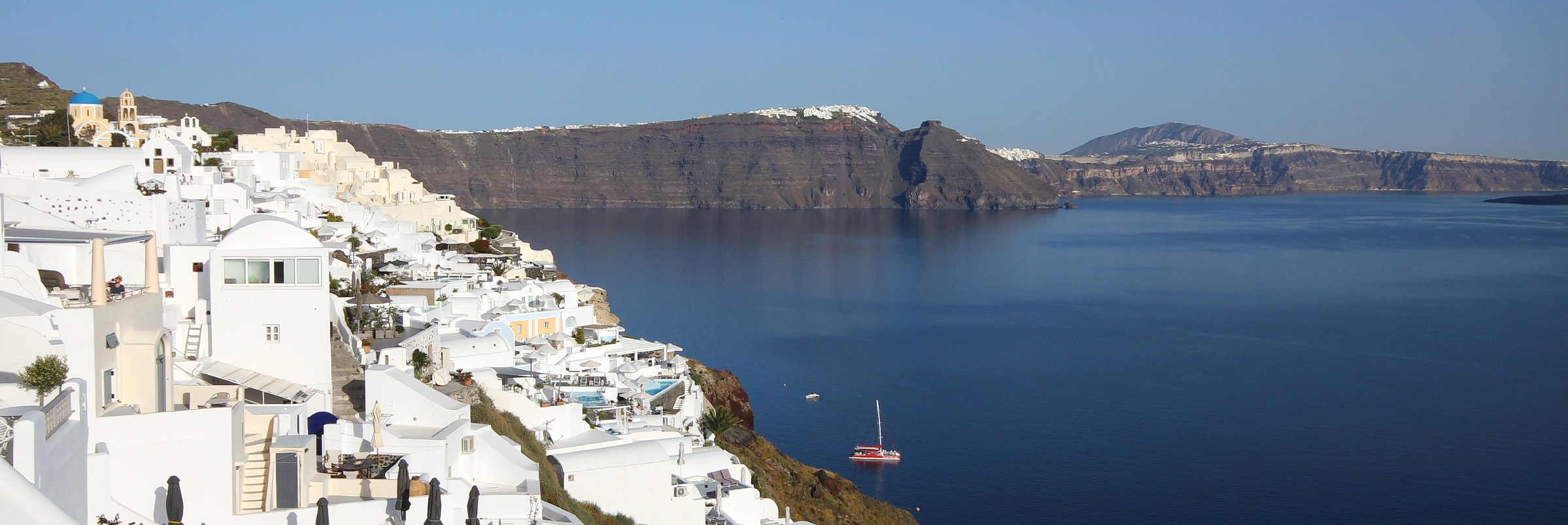
THE ISLAND | The caldera, the clifftop village of Imerovigil (centre), the bustling island’s capital of Fira (right of centre), and southern Santoríni as seen from the northern village of Oia. Santoríni, Cyclades, Greece. April 28, 2017.
Seahorse-shaped Santoríni is small. It’s approximately 73 km² (28 sq mi) in size, is no wider than 6 kilometres east to west, and, were you up for it, it takes about 5 hours to walk the 25 kilometres from the Akrotiri Lighthouse on its southern tip (seen here in the distance beyond the island settlements of Imerovigli and Fira) to the village of Oia on its northern tip – the walk skirts the island’s caldera-facing eastern edge with, and as you might imagine, splendid caldera views every step of the way.
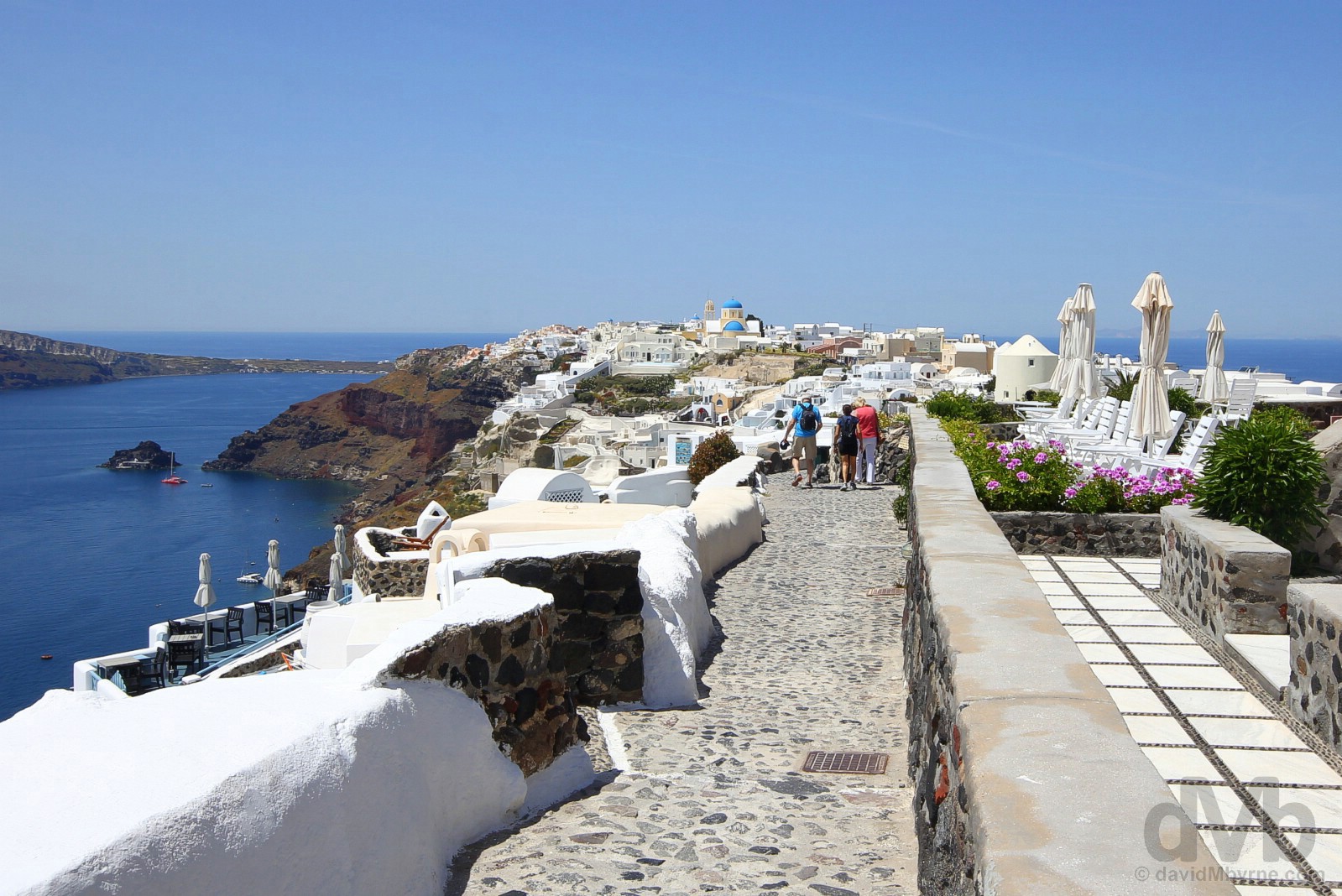
CLIFF WALK | Approaching the northern village of Oia as seen from the 10-kilometre Fira to Oia Cliff Walk, a small portion of which I walked daily, about as adventurous I got on the island. Santoríni, Cyclades, Greece. April 28, 2017.
There’s plenty to keep you occupied on Santoríni from sunup to sundown, if that’s your want: there’s a late 17th century lighthouse (Akrotiri Lighthouse); there are beaches, mostly volcanic black sand and pebbles (for all its allure, Santoríni is not a beach destination); museums; volcanic landscapes; chic galleries and boutiques; and even a microbrewery and vineyard (Santoríni is one of Greece’s most important wine producers). And there’s culture too: churches; a Bronze Age-era archaeological site; and Byzantine castle and mountaintop ruins (Ancient Thera). But Santoríni isn’t that kind of location, or it wasn’t for me. It was never going to be. Knowing culture – and effort – lay in wait elsewhere in Greece, I was happy to while away a few languorous days drinking in caldera views (and Mythos beers) and exploring the sineous lanes of Oia in the build-up to the day’s main event, sunset from the walls of Oia’s Byzantine Castle ruins (get there early). Wash, rinse, repeat. One day melted into another. Effortlessly.
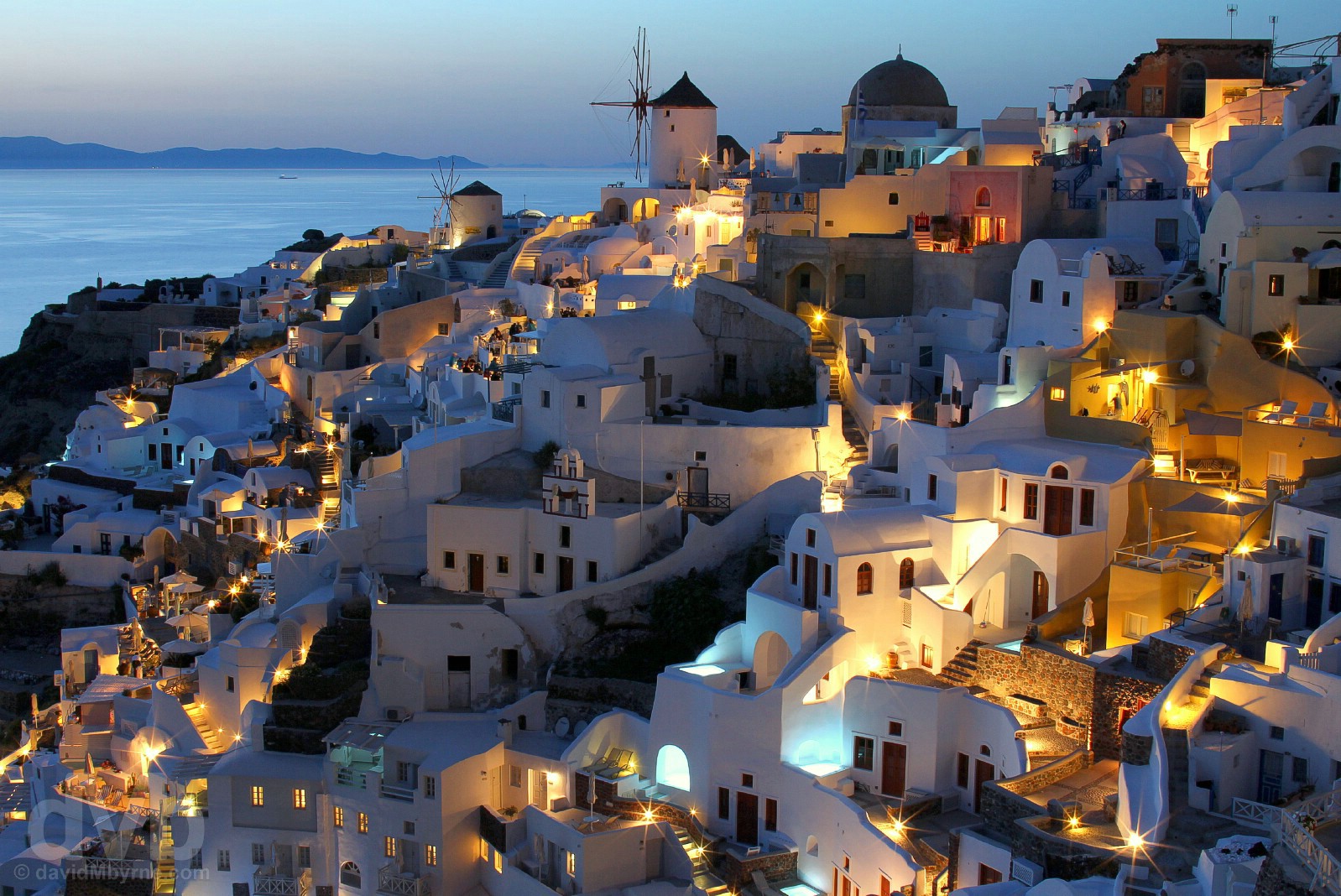
SANTORINI DUSK | Dusk over the village of Oia, Santoríni, Cyclades, Greece. April 28, 2017.
It feels like the whole island congregates at Oia’s small Byzantine castle ruin to catch the evening sunset, easily the biggest event of the Santoríni day. Lovers canoodle and photographers, the more serious among them having set up shop in a prime location well in advance, adjust settings and filters. There’s really only one vista on offer for those in attendance as the sun sets below the horizon to the west (left), the one seen here looking from the castle ruin across to Oia’s hillside dwellings and iconic windmills (the larger of the two is rented as a villa but needs to booked upward of 9 months to a year in advance) at the tip of the island, which is why this invariably is the Santoríni post sunset (dusk) shot seen all over the internet. This just happens to be my version of it.
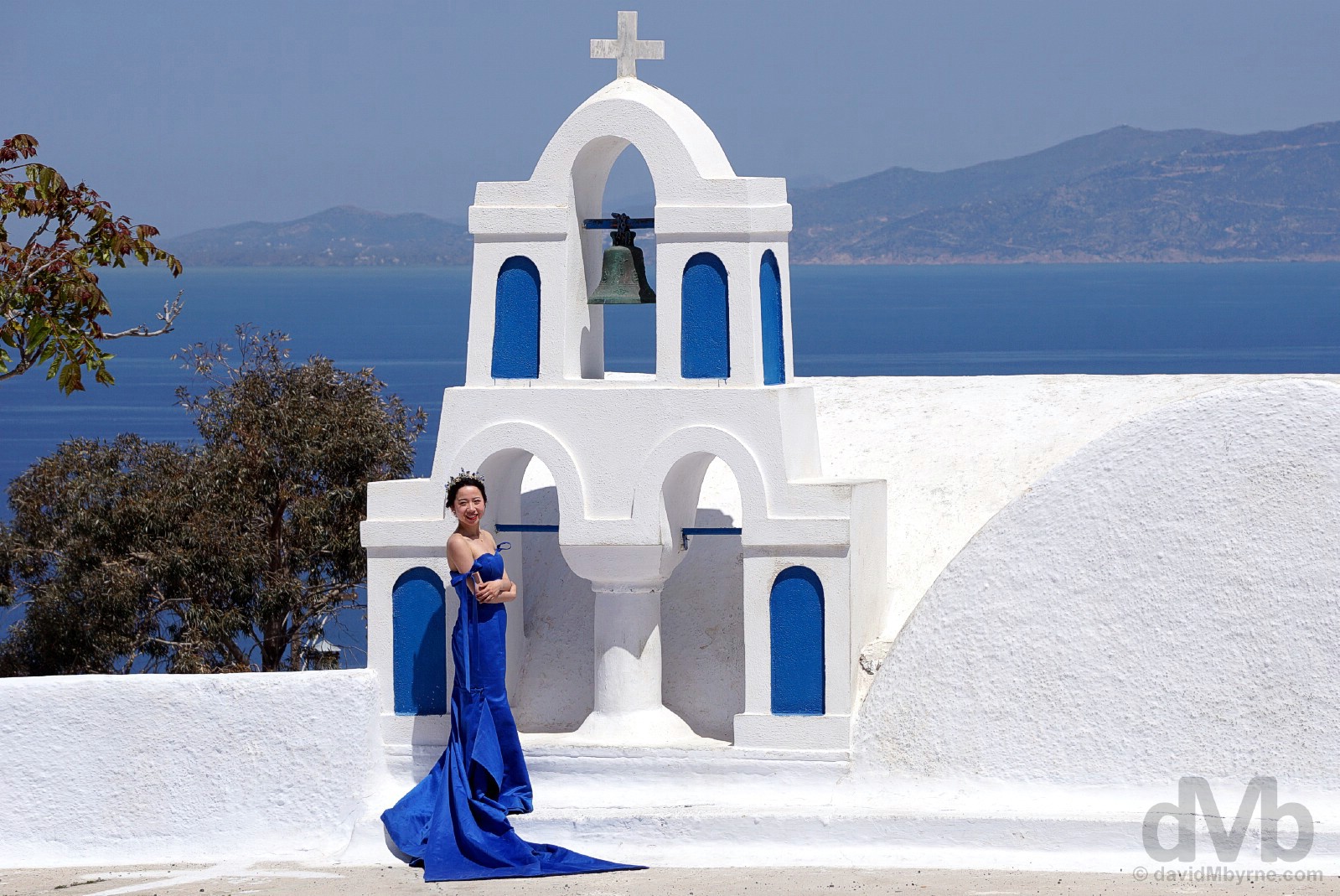
BRIDAL PARTIES | A bride in Oia, Santoríni, Cyclades, Greece. April 28, 2017.
If you’re looking for anyone or anything to blame, it’s the success of the 2014 Chinese romance movie Beijing Love Story. Partly filmed on Santoríni, the movie was unfortunately a hit domestically (it garnered some success internationally too) meaning these days you’re guaranteed (mark my words) to see Chinese newlyweds being martched from one scenic Oia location to another by an utterly ridiculous bevy of supporting crew (lighting technicians, makeup artists, artistic director, assistants and, of course, the photographers, plural), all no doubt under pressure to deliver the goods. They can’t really mess it up, can they? The list of places on earth more photogenic than (an early morning or late afternoon) Santoríni would be a short one.
Oia. Where Santoríni smart reaches its zenith. The picturesque clifftop village of Oia is one of the most desirable locations in the Cyclades. It’s built hugging precariously to the eastern slope of the caldera at the very northern tip of the island, far enough removed from the other island settlements so as to be distinguishable, both visually and geographically, from them. Something of a Santoríni pheonix, it was largely rebuilt following the utter devastation of the 1956 earthquake, which hit the village particularly hard. Today Oia is a typical Cycladic settlement of whitewashed cubic architecture and trendy galleries, boutiques, jewellery stores, cafes, restaurants, and high-end accommodation, most of which nestle in niches hewn into the volcanic rock and all of which are connected by pedestrian passageways, myriad inclines and declines, and countless numbers of steps. Oia is one destination in which to pound the pavements, and what beautiful, bright and explorable pavements they are.
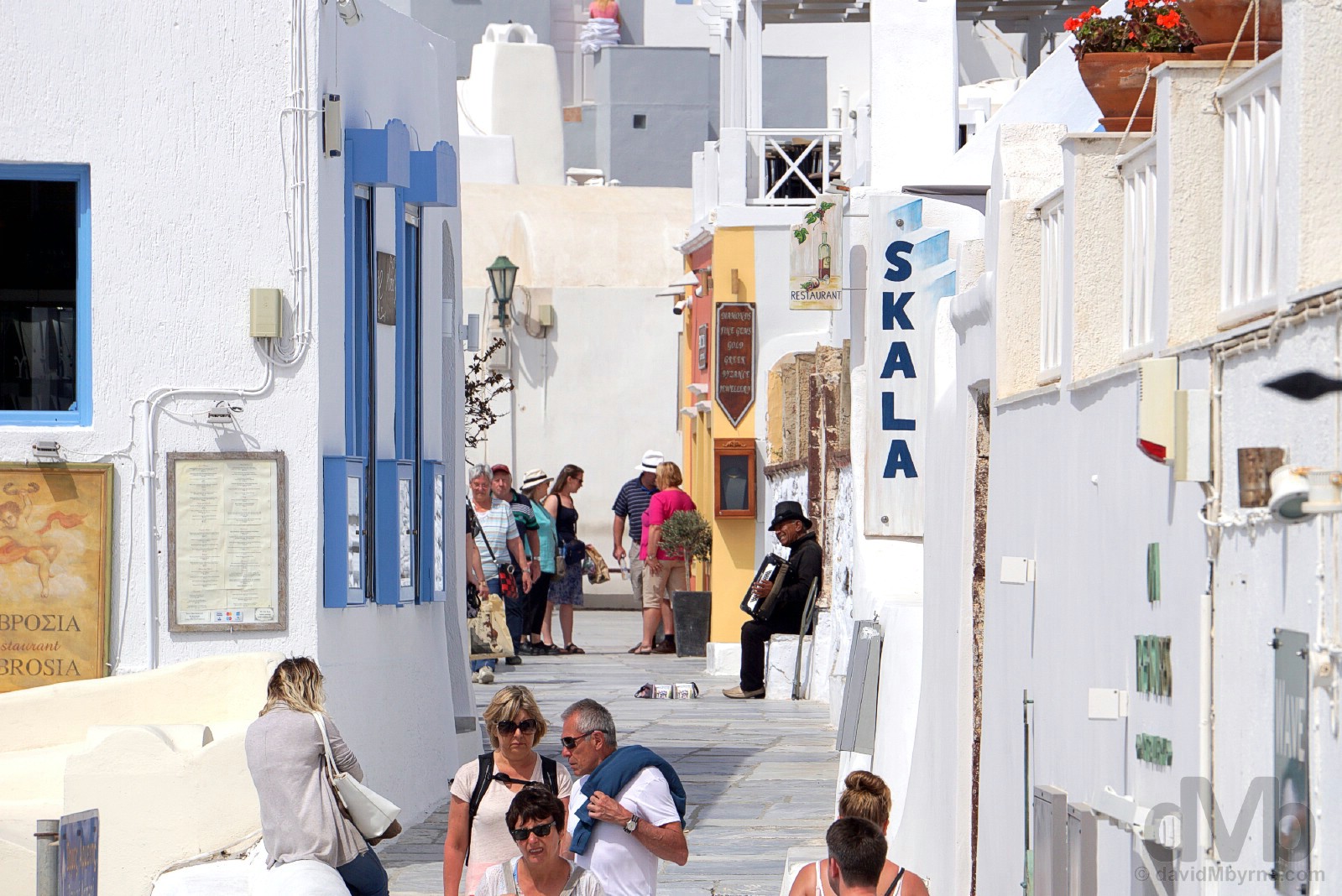
Nikolaou Nomikou, the main whitewashed (sunglasses recommended) pedestrian thoroughfare in the village of Oia, Santoríni, Cyclades, Greece. April 29, 2017.
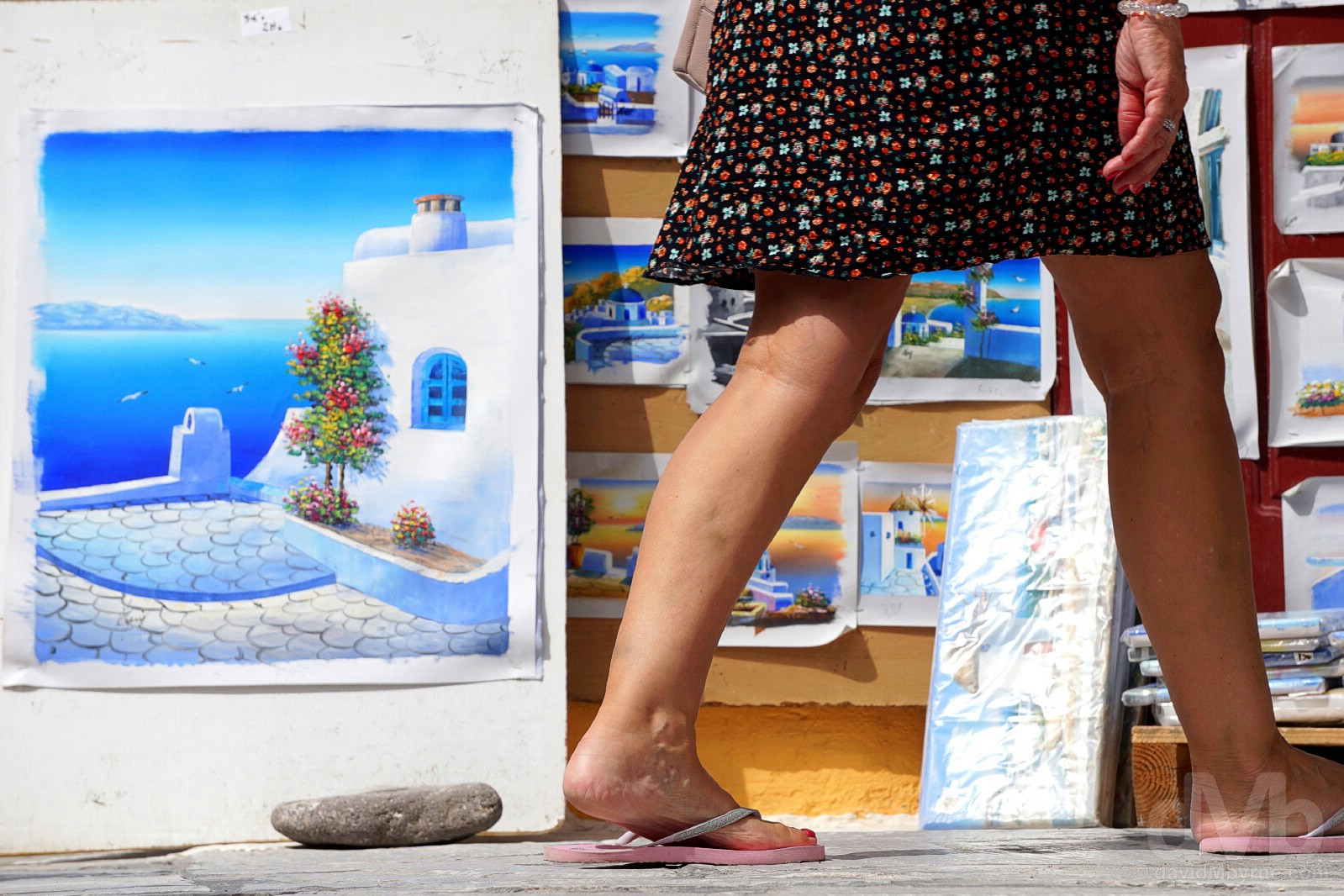
Art for sale in the lanes of Oia, Santoríni, Cyclades, Greece. April 29, 2017.
Signing Off | The Complete Santoríni Gallery

